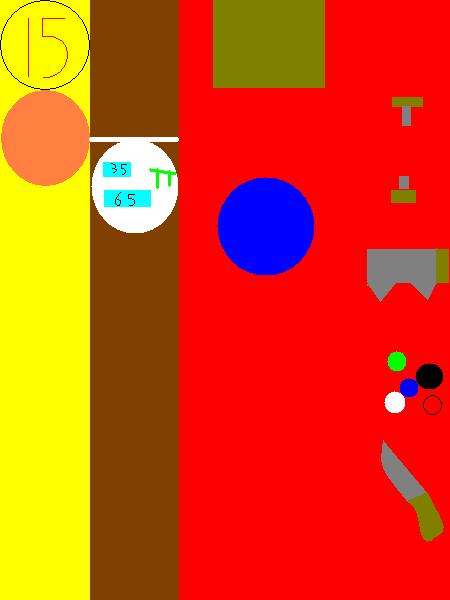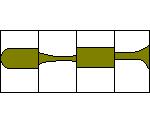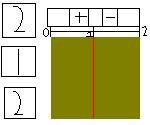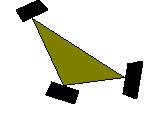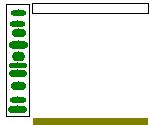GCPP:Proposal-Feinte
Puzzle Codename: Feinte
| Contact | |
| Username: | Aliono |
| Additional contact info: | Inumo on Sage, shiyaru900@yahoo.com |
| Project forum thread: | Here. |
Contents |
Game concept
Similar to Cake Mania mixed with the Spore creature creator.
Objective
Create a piece of furniture according to a customer's given parameters.
Gameplay
On the left side of the screen, separated by a counter, is a customer with a counter (we'll get to this later). Also on this side is a service countdown. Using W, A, S, and D, a player would move his on screen character to the customer and press the space bar. From there a small speech bubble would appear, displaying two bars (with numbers) and an image. The bars are stability, and elegance, while the image is of a painted table, chair, bed, cabinet, or other piece of furniture. From this, the player must create said piece of furniture and get as close to the parameters as possible. On top of the counter is a small display, showing the parameters of the current piece of furniture that a player would be making. On the right side of the counter is a lathe, a set of saws, a carving knife, one to three large worktables, and some paint buckets. The player must use these tools (and complete the puzzles relating to them) to create the piece of furniture the customer ordered as fast as possible. The longer he or she takes, the more the customer's counter drops (I told you we'd get to it), and the less score he or she gets. After creating the piece of furniture, the player takes it back to the customer and obtains his score.
Neophyte Level Storyboard
Fisttothegut is a Neophyte furnisher. As he is still new, he only has to deal with stability and elegance, along with any paint colors the customer wants. Walking over to the counter, he sees a customer. Pressing the space bar, a small speech bubble appears. The pair of gauges indicate that the customer wants 35 stability, and 65 elegance in a green table (see image 1 for general idea).
Walking over to the lathe, he presses space bar again and stops to think. I haven't made this sort of choice before, he thinks. I'll try making elegant legs. The customer's counter starts counting at what he knows is a quarter speed and a small window opens. Looking at a row of four boxes, making a mismatched picture of a leg, he clicks on them one at a time until the boxes match up into a thin leg (see image 2 for general idea). He waits for the legs to finish, then picks them up. Walking over to the saws, he presses space bar again and looks at the new puzzle as the customer's counter slows down again. Along the left side, three numbers sit in boxes. On top is a semi-empty box with a + and - sign. In the center is a wood colored box with a red line down the middle and a mini ruler on top (see image 3 for general idea). Using the numbers on the left, he creates an equation with an answer the same as the red line's number.
After his tabletop is finished, he checks back to the counter's display, and sees that he has 50 stability and 50 elegance so far. Do I want to stick with this, or should I do some carving on the table? Thinking, he decides to do some carving. Walking over to the carving knife, he is faced with a new set of choices: minor, normal, and major. I don't think I can re-carve a piece of furniture, so I need to think. A fifteen point carving need is not something I'd call minor, but not necessarily major either. I'll go for normal. Clicking "normal," Another window opens, displaying a geometric shape with blocks on the end (see image 4 for general idea). By clicking on the blocks, he changes the angles to the best estimated fit and starts the scissors. He waits again for the table to finish.
Once he has everything, he checks back to the display. Apparently he had made a small mistake in the carving, and only achieved 60 elegance and 35 stability. Moving on to the worktable, he presses space bar and assembles the table. From there he moves on to the paint and presses space bar to start up another puzzle as the counter slows down. On the left is a box with a number of rollers. Below is a wood piece. Above is a small bar (see image 5 for general idea). Mousing over the bar, he clicks at various random points, dropping rollers onto the wood below. After he's done, he waits for his table to finish being painted. Finally, he walks back to the counter and hands the table to the customer.
Storyboard Score
Fisttothegut finished the job somewhat fast. The customer's counter was at five (Cs = 50). He had almost perfect accuracy (As = 95). There were no bonuses. He painted 95% of his table (Ps = 5). His end score was 140 (50 + 95 + 0 - 5); basic work, a fair job.
Broad Storyboard
Rocktotheface is a Broad furnisher. Because of this, he has to deal with stability, elegance, and attachments. However, he also gets gilt and elegant helpers. Walking over to the counter, a group of three customers file in. He opens up each of their speech bubbles. Customer one wants an even fifty-fifty yellow chair. Customer two wants a fifteen-eighty-five red cabinet. Customer three wants a thirty-seventy blue table with a pedestal attachment.
He starts up the lathe, matching up the legs to a mid-elegant level for customer one. As they begin being made, he picks up a piece of gilt from the counter and moves over to the saws. Initiating the puzzle, he uses his numbers to create the walls and shelves of customer two's cabinet. After he's done that, he moves the legs off onto one of the worktables and starts up the cabinet's supports on the lathe. After finishing matching up the blocks for an elegant leg, he takes the now-carved cabinet sides and takes them to the carving knife. He makes a major carving, then puts the sides on a separate worktable. From there he cuts the chair seat for customer one, then takes the legs and assembles the cabinet while the chair seat is made. From there he takes the chair seat and assembles the chair, then paints them yellow. After that, he paints the cabinet and delivers it and the chair.
As the two file out, he waits on picking up the pay until after he's finished customer three's table. He stops to think. I've never made an attachment before. I think I'm supposed to build a pedestal as if it were a legless table that goes on top. I guess I'll find out soon enough. Starting the lathe up, he makes semi-elegant legs. After he's finished starting it up, he moves on to the saws to create a tabletop. From there, he picks up the legs and puts them on the worktable. After he's finished, he heads over and picks up an elegant helper, to go with his gilt. He sets his gilt and helper onto the worktable as well. Afterwards, he starts up the saws again. He makes a pedestal, then moves the pedestaled tabletop onto the worktable, assembling it. Finally, he paints it and gives it to customer three.
Storyboard Score
Rocktotheface completed customer one's job and customer two's job at the seven counter mark. He finished customer three's job at the five counter mark (Cs = 70 + 70 + 50). He completed the first two customer's jobs with perfect accuracy. He finished customer three's job with twenty-five-one hundred twenty (As = 100 + 100 + 145). He used one gilt and one elegant helper (Bs = 0 + 0 + 75). He had perfect painting all the way (Ps = 0 + 0 + 0) His end score was 610 points (190 + 345 + 75 - 0); skilled work, a good job.
Scoring
Players get score (Cs + As + Bs - Ps) based on the customer's counter (Cs = counter * 10), accuracy of the gauges (As = [piece stability + piece elegance + (if there are correct attachments) 50] - [customer stability + customer elegance + (if there are attachments) 50] + 100), and any acquired bonuses (Bs = [gilt * amount of gilt] + [elegant helper * number of e-helpers] + [stability helper * number of s-helpers]) added together (the equations in parenthesis are for deciding those parts) minus any paint deductions (Ps = 100 - percentage of piece painted). The counter starts at 10. You can better the customer's specifications. Gilt is worth 25 points apiece. Elegant helpers increase the elegance of a piece by 50 and are worth 50 points. Stability helpers increase the stability of a piece by 75 points.
Variability
Color, piece, and specifications of an order can change, along with other attachments.
End criteria
When the service countdown is complete, the game ends.
Difficulty scaling
- Novice: Only stability, no bonuses, one customer at a time, 3 lathe boxes, 2 saw operations, 3 carving angles, 10 rollers.
- Neophyte: Stability and elegance, no bonuses, one customer at a time, 4 lathe boxes, 2 saw operations, 3 carving angles, 9 rollers.
- Apprentice: Stability and elegance, only gilt, two customers at a time, 4 lathe boxes, 3 saw operations, 3 carving angles, 7 rollers.
- Narrow: Stability and elegance, gilt and elegant helpers, two customers at a time, 5 lathe boxes, 3 saw operations, 4 carving angles, 6 rollers.
- Broad - Solid: Stability, elegance, and attachments, gilt and elegant helpers, three customers at a time, 5 lathe boxes, 4 saw operations, 5 carving angles, 5 rollers.
- Weighty - Sublime: Stability, elegance, and attachments, gilt, elegant helpers, and stability helpers, three customers at a time, 6 lathe boxes, 5 saw operations, 6 carving angles, 5 rollers.
Crafting type
Furnishing
Known problems
- Control scheme may need to be adapted for Java.
- Display issues may need to be worked out.
- Colors will need to be adapted for colorblind people.
- Higher leveled puzzles may need to change due to fitting everything in.
- Displaying multiple pieces at once on the counter display won't work without thinking it over.
Notes
- I need an artist if someone wants to volunteer.
- I like the idea of many mini-games rather than one big game.
Images
Image 1
The yellow thing in the upper left with the red numbers is the service counter. The peach thing below it is a customer. The blue circle in the center is the player. The brown bar is the counter (the player isn't making anything, so there's nothing on the display). The items (going clockwise) are the worktable, the lathe, the saw, the paint, and the carving knife.
Image 2
This is a Neophyte or Apprentice's lathe puzzle. On this side only, I'm showing stable, elegant, stable, elegant, though there are mid-ranges to each type.
Image 3
This is a Novice's saw puzzle. You can tell because of the gap of only 2 cm.
Image 4
This is an Apprentice's carving puzzle. You can tell because it is neither an equilateral, isosceles, or right triangle.
Image 5
This is a Novice's painting puzzle. You can tell because of the 10 rollers.
